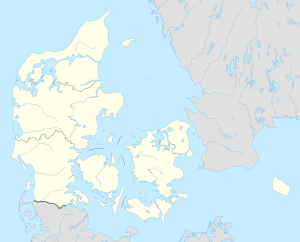Great Belt Railway Tunnel
| Great Belt Railway Tunnel | ||
|---|---|---|
| Official name | Storebælttunnelen | |
| use | Railway tunnel | |
| traffic connection | København – Fredericia railway line | |
| place |
Korsør , Nyborg Denmark |
|
| length | 8024 m | |
| Number of tubes | 2 | |
| Largest coverage | 75 m | |
| construction | ||
| start of building | 1988 | |
| completion | 1997 | |
| business | ||
| release | June 1, 1997 | |
| map | ||
 Detailed map of the Great Belt with Storebælt Bridge and Great Belt Railway Tunnel
|
||
| location | ||
|
|
||
| Coordinates | ||
| West portal | 55 ° 20 ′ 5 " N , 10 ° 58 ′ 21" E | |
| East portal | 55 ° 20 ′ 52 ″ N , 11 ° 6 ′ 16 ″ E | |
The Great Belt Railway Tunnel connects the Danish island of Sprogø with the Danish town of Korsør on Zealand in the east and is part of the fixed Great Belt crossing (bridge and tunnel connection for both road and rail vehicles) to Nyborg on Funen in the west.
Technical conditions
Because of vibration problems that would have resulted from a guided tour over a combined rail-road suspension bridge, it was decided to run the København – Fredericia railway through a tunnel. The railway tunnel is designed as a two-tube tunnel with two 8,024 m long single-track tubes, which are connected to one another by 31 cross- passages and which can each serve as rescue tunnels.
The shell of the tunnel was constructed with four tunnel boring machines from 1988 to 1996. The railway line has a maximum gradient of 22 ‰, is electrified and was opened to rail traffic on June 1, 1997. The tunnel runs 12 to 40 m below the sea floor, its deepest point is 75 m below the sea surface. The tunnel replaces the previous ferry connection from Korsør to Nyborg and shortens the train travel time from Copenhagen to Jutland by 60 minutes. In the western part of the crossing, the railway line runs next to European route 20 over Storebæltsbroen .
The draft of the ships that pass through the tunnel is limited to 15.4 m ( see Baltimax ). The Öresund as an alternative route, on the other hand, only allows a draft of 8 m and the Kiel Canal 9.5 m. The Storebælt Bridge allows max. 65 m height.

